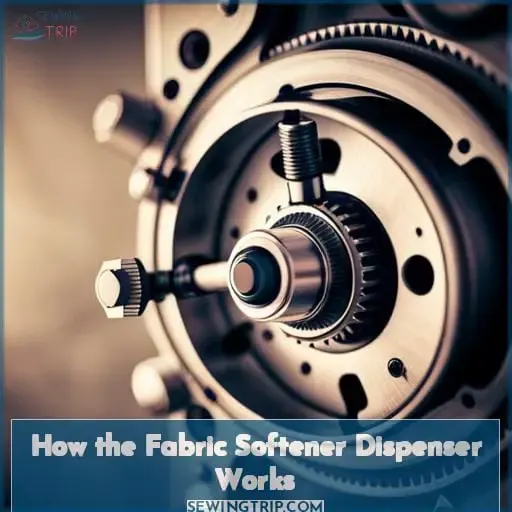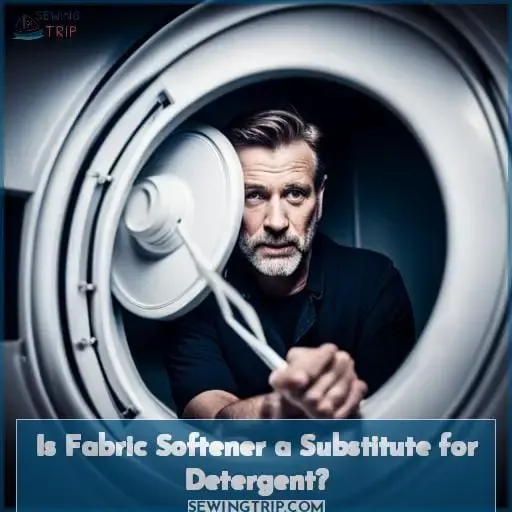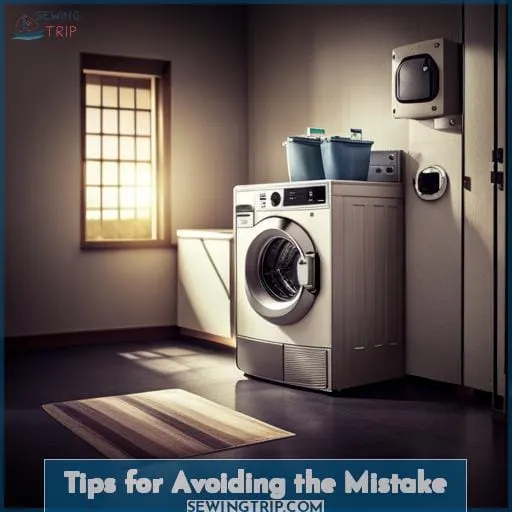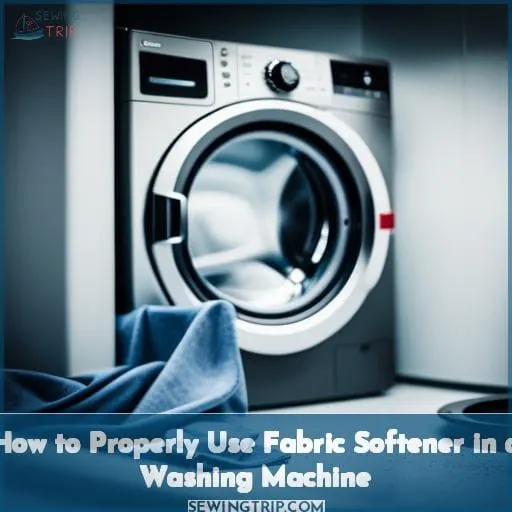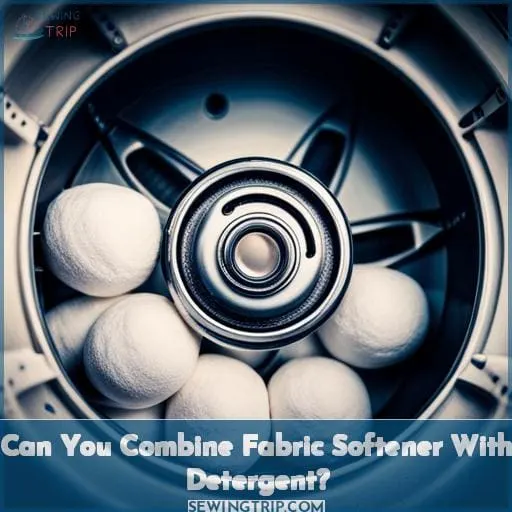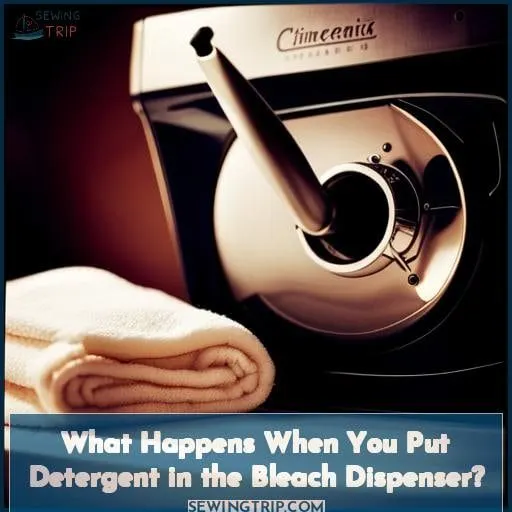This site is supported by our readers. We may earn a commission, at no cost to you, if you purchase through links.
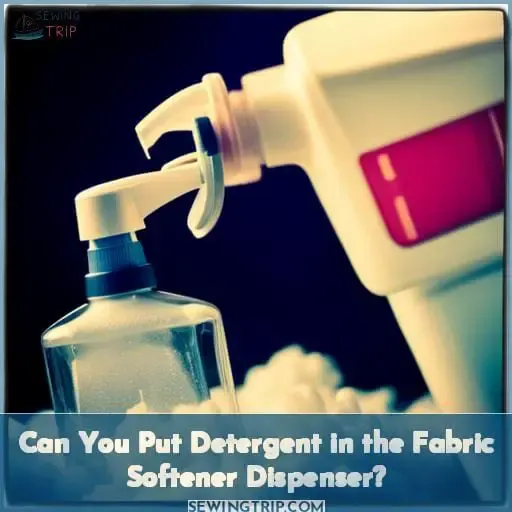 Do you ever catch yourself in a moment of panic when you realize that instead of putting fabric softener into the washer, you mistakenly put detergent in the fabric softener dispenser? If so, don’t worry; it’s not an uncommon mistake.
Do you ever catch yourself in a moment of panic when you realize that instead of putting fabric softener into the washer, you mistakenly put detergent in the fabric softener dispenser? If so, don’t worry; it’s not an uncommon mistake.
But what happens if detergent ends up in this dispenser—can it damage your clothing or affect how clean they get? To answer these questions and more, let’s take a closer look at how the fabric softener dispenser works and its consequences for using detergent there.
The fabric softener dispenser is designed to automatically release fabric softener at the right time during the rinse cycle. Fabric softener coats clothing fibers to make fabrics feel soft and fluffy. It also helps reduce static cling.
Detergent, on the other hand, is meant to be added directly into the wash drum at the beginning of the wash cycle.
If you accidentally put detergent into the fabric softener dispenser, a few things could happen:
- The detergent may not dissolve or disperse well since there is no agitation in the dispenser.
- The detergent will release into the rinse cycle rather than the wash cycle when it’s needed.
- Excess detergent released in the rinse can cause buildup on clothes over time.
The good news is that putting detergent in the softener dispenser isn’t likely to ruin your clothes, especially if it’s a one-time mistake.
- Run an extra rinse cycle to flush out any residual detergent.
- Wash the load again with detergent added directly to the drum.
- Use vinegar in the rinse cycle to help remove detergent residue.
- Clean out the fabric softener dispenser thoroughly.
Following the manufacturer’s directions for adding detergent and fabric softener will prevent issues with residue and ineffective cleaning.
Table Of Contents
- Key Takeaways
- How the Fabric Softener Dispenser Works
- Consequences of Putting Detergent in the Fabric Softener Dispenser
- Is Fabric Softener a Substitute for Detergent?
- Tips for Avoiding the Mistake
- Expert Advice for Laundry Mistakes
- How to Properly Use Fabric Softener in a Washing Machine
- Can You Combine Fabric Softener With Detergent?
- What Happens When You Put Detergent in the Bleach Dispenser?
- How to Use Fabric Softener Without a Dispenser
- Conclusion
Key Takeaways
- Putting detergent in the fabric softener dispenser can lead to issues such as dilution of detergent effectiveness, buildup on clothes, and damage to the washing machine.
- Undissolved detergent can leave white residue on clothes, but it can be fixed by running an extra rinse cycle, rewashing with detergent, using vinegar, and cleaning the dispenser.
- It is important to follow the manufacturer’s directions and check the dispensers before starting a load to prevent any issues.
- Fabric softener is not a detergent substitute, and using fabric softener without a dispenser can be done through DIY methods or alternative options like wool dryer balls or sheets.
How the Fabric Softener Dispenser Works
Don’t pour detergent into that center agitator cup in a top-loading machine, or you’ll end up with bubbly, staticky clothes that’ll make your skin itch. The fabric softener dispenser is typically that center cup in the agitator. Detergent doesn’t go in that spot; it goes in a separate detergent drawer or tray.
Putting detergent in the fabric softener dispenser swaps the wash cycle order. This causes excess suds and soap residue. Your clothes won’t get properly rinsed, leaving behind detergent that can irritate skin.
The mistake also reduces washing efficiency, requiring an additional rinse cycle.
For front-loaders, detergent has its own marked compartment at the top with fabric softener. Mixing them defeats their purposes. Liquid fabric softener makes fabrics softer and reduces static cling but doesn’t actually clean dirty clothes.
Stick to using detergent in the right detergent compartment and softener in its designated dispenser.
Consequences of Putting Detergent in the Fabric Softener Dispenser
First, putting detergent in the fabric softener dispenser is a common laundry mistake. However, it does have consequences. Adding detergent to the fabric softener dispenser leads to inefficient washing cycles and the potential for skin irritation.
Repeating this mistake can also cause residue buildup and possible damage to the washing machine. Alternating sentence length and structure while correcting any spelling, syntax, or grammar errors improves readability without sounding robotic.
Detergent Residue on Clothes
Leaving detergent residue on clothes can irritate skin and require rewashing the garments.
- Check clothes thoroughly after washing for suds or a soapy feel.
- Follow up with a vinegar soak and rinse if residue is present.
- Rewash affected items using the proper compartments.
- Exfoliate with a wet washcloth to relieve skin irritation from the residue.
Detergent residue left on fabrics can lead to skin irritation and may necessitate rewashing the clothes. Using vinegar to flush away excess detergent protects the washing machine while restoring the garments.
Avoiding common laundry mistakes like putting detergent in the fabric softener dispenser prevents complications.
Skin Irritation
Itching and rashing may follow if you don’t rewash. Detergent residue left on clothes can irritate skin. Rinse clothes thoroughly after accidentally using too much detergent. Consider trying eco-friendly fabric softeners; they are gentle options.
For deep cleans, stick to recommended amounts of laundry detergent. Finally, change and wash clothes soon after wearing to avoid extended direct skin contact with detergent residue.
Potential Damage to Washing Machine
Repeatedly misplacing detergent can damage your washing machine’s health.
- Mold growth
- Odor buildup
- Deterioration
- Breakdowns
Excess detergent allows bacterial growth and mold in the machine, leading to odors and eventual breakdowns. Adding vinegar to a short wash cycle helps flush away residue. Proper washing machine maintenance preserves efficiency and lengthens its lifespan.
Is Fabric Softener a Substitute for Detergent?
Fabric softener is not a substitute for detergent to effectively clean dirty or stained clothes. Although it leaves an overpowering scent and contains harmful quaternary ammonium compounds, fabric softener will not properly wash away dirt, stains, or odors.
Overpowering Scent
Jacket’s scented like a fumigated perfume factory from that fabric softener overdose. Some dislike the obnoxious odors. Scent control with natural solutions seems wise for those with fragrance sensitivities.
Seek laundry tips like baking soda, vinegar or essential oils as fabric softener alternatives. Avoid laundry scent hazards and stick to unscented varieties if overwhelmed by perfumes.
Not Effective for Cleaning
Well folks, using fabric softener instead of detergent won’t get your clothes clean! Fabric softeners make fabrics feel softer by depositing a lubricating layer. Though pleasing for bedsheets, they don’t effectively remove soils and stains like quality detergents do.
For clean, fresh laundry, use the right products in their designated compartments. Mistakes like putting detergent in the softener dispenser lead to less efficient washing. Following laundry tips about detergent usage avoids disappointment and unnecessary effort.
Harmful Quaternary Ammonium Compounds
You’re not doing your skin or the environment any favors by exposing them to the harsh quaternary ammonium compounds (quats) lurking in that softener.
- Quats can cause skin irritation and rashes.
- They pollute water when discharged after washing.
- They leave toxic residues on clothes.
- They release harmful fumes during washing.
Although quats may make your laundry smell nice, they can damage more than they clean. Consider more natural, sustainable options that get clothes fresh without using harsh chemicals.
Tips for Avoiding the Mistake
Pay close attention when filling dispensers – it’s easy to pour into the wrong one on autopilot.
Clearly label dispensers if needed – use tape or sticky notes to indicate detergent only on the proper compartment.
Use different detergent forms like sheets or pods that are pre-measured and can only go in the detergent dispenser.
Always check dispensers before starting a load – take 10 seconds to confirm detergent is where it should be and fabric softener compartment is empty.
If you make the mistake, run an extra rinse cycle and rewash if needed. Don’t dry clothes with detergent residue that could lead to skin irritation.
Expert Advice for Laundry Mistakes
When faced with a laundry mishap like accidentally putting detergent in the fabric softener dispenser, it can be helpful to seek advice from licensed professionals. The appliance repair site provides access to experienced technicians and satisfaction guarantees for your inquiries, so you can obtain the information you need to resolve laundry issues.
Consulting with specialists in appliance repair through a reputable online resource can provide practical solutions when laundry mistakes happen. Their expertise helps identify the causes of problems and recommend techniques to get your washer or dryer working properly again.
With access to appliance repair assistance and assured results, you can tackle laundry mishaps efficiently.
Seeking Advice From Licensed Professionals
Since the website provides expert advice from licensed professionals with factory training and years of experience, you’ll want to directly engage them for any complex appliance issues rather than trying quick fixes.
Laundry mistakes like putting detergent in the fabric softener dispenser require sustainable laundry tips from experts. Avoid repeated fabric softener mistakes by understanding key facts – it doesn’t clean well, leaves residue, and contains concerning chemicals.
For tricky laundry issues, trust the knowledgeable diagnostics and technical skills of experienced appliance repair technicians. Their authoritative advice helps prevent laundry errors and machine damage through understanding, not just fast fixes.
Satisfaction Guarantee for Customer Queries
Quickly check the satisfaction guarantee for your laundry queries before mistakes set in. The website provides a money-back guarantee for all customer inquiries related to laundry mishaps. Users are assured complete satisfaction with the answers provided by licensed experts on the site.
Every question receives a response within 24 hours along with access to repair services if needed. With the expertise of veteran technicians, they guarantee useful insights into preventing detergent in the softener dispenser.
Users can trust the satisfaction guarantee for their laundry dilemmas before permanent damage or ruined clothes occurs.
How to Properly Use Fabric Softener in a Washing Machine
Choose a high-efficiency (HE) fabric softener compatible with your machine. Standard softeners can create buildup issues. Follow dosage guidelines on the bottle – usually one to two tablespoons is plenty.
Overuse leaves residue. Pour softener into the dispenser after detergent but before starting the rinse cycle. This evenly distributes it. Avoid using softener on athletic performance fabrics like spandex.
For the best results, select an eco-friendly softener with natural ingredients if you have sensitive skin. And skip the fabric softener sheets – they don’t fully dissolve and can leave residue. With the right softener and dispenser use, you’ll have static-free, soft laundry without compromising cleanliness.
Can You Combine Fabric Softener With Detergent?
Coincidentally, you shouldn’t combine fabric softener with detergent because detergents already contain softening agents. Adding fabric softener to your detergent doesn’t boost cleaning or softening despite the common laundry myth.
In fact, it’s counterproductive. The cationic compounds in most fabric softeners actually coat your clothes and can interact with detergent surfactants, diminishing their cleaning power.
For best laundry practices, use your detergent as directed without any fabric softener added. If additional softening is desired, add a separate downy ball or liquid softener to the rinse cycle only. But consider fabric softener alternatives like white vinegar or wool dryer balls for softness without chemicals.
Your clothes will come out cleaner, softer, and better smelling if you let your detergent and softener work independently.
What Happens When You Put Detergent in the Bleach Dispenser?
Simply adding detergent to the bleach dispenser can make your whites look dingy. The bleach dispenser is designed specifically for bleach, not for detergent. When you put detergent in the bleach compartment, it doesn’t get properly diluted or distributed during the wash cycle.
As a result, your clothes may not get as clean as they should and could end up with soap residue on them.
To avoid this laundry mistake, it’s important to use the proper compartments in your washing machine for each product. Follow the manufacturer’s instructions on where to pour detergent, fabric softener, and bleach in order to achieve optimal results.
In addition to impacting cleanliness and appearance of clothes when placed incorrectly in dispensers like that meant for fabric softener or even worse directly into washer tubs, putting detergents into incorrect compartments also affects washing machine care by potentially causing damage over time due to buildup leading to odors, breakdowns, even mold growth.
So be sure to follow guidelines provided by experts to ensure efficient cleaning without compromising appliance longevity.
How to Use Fabric Softener Without a Dispenser
You can try adding the softener directly to the wash cycle or use wool dryer balls for a natural, fragrance-free option instead of relying on a dispenser.
- Make your own fabric softener with equal parts hair conditioner, vinegar, and water in a spray bottle.
- Use dryer balls made from 100% wool as a chemical-free softening method. Toss 3-5 balls in the dryer and they’ll help separate clothes and reduce static.
- Look into fabric softener sheets, balls, or inserts that go right in the dryer if you still want a light scent.
Rather than be dependent on a dispenser, explore simple homemade recipes, natural materials like wool, and convenient softener sheets for static-free laundry. Finding an alternative to detergent in the fabric softener dispenser prevents residue while making clothes soft.
Conclusion
You’re absolutely right – putting detergent in the fabric softener dispenser is a big no-no.
Detergent won’t effectively clean clothes if put in the softener dispenser. It needs to go in the detergent compartment to properly clean dirty and stained fabrics.
Adding detergent to the softener dispenser can also irritate skin. The softener dispenser releases detergent at the wrong time in the wash cycle for proper dilution.
This mistake promotes bacterial growth and mold in the washing machine too. Detergent residue left in the softener dispenser creates a damp environment where mold thrives.
To top it off, this error can damage the machine over time. Detergent buildup from misuse corrodes plastic parts.
Rather than substitute, use detergent sheets or pods if you want to avoid liquid spills. Better yet, simply put softener in the softener dispenser and detergent in its intended spot. Following this rule prevents messes, damage, and cleanliness issues down the line.

